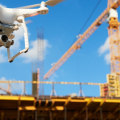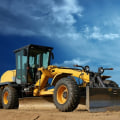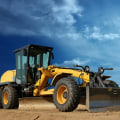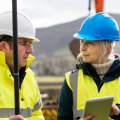- Not Wearing Personal Protective Equipment (PPE)
Donning the right Personal Protective Equipment (PPE) is critical when handling construction equipment to avoid potential harm. Such items include hard hats, safety glasses, and steel-toed boots. Bypassing these pieces of gear can lead to severe injuries like head traumas, eye damage, and foot wounds.
- Not Reading the Equipment Manual
Before utilizing any construction machinery, it is essential to read the manual. This guide contains vital information about the apparatus, including instructions on how to use it securely and efficiently. If you don't peruse the handbook prior to operating a piece of equipment, mistakes might happen that can harm either your tools or yourself!
- Improper Use of Equipment
Mishandling of equipment has the potential to cause grievous accidents and harm. For instance, lifting large objects with a bulldozer is not just ill-advised but also unsafe as it could potentially result in a catastrophic tipping over incident. To avoid such disasters, always utilize your machinery according to its intended purpose and adhere strictly by the manufacturer's instructions.
- Overloading Equipment
Pushing your equipment beyond its limits can result in not only extensive damage, but even more concerningly, potentially put lives at risk. To avoid any issues from occurring, always abide by the manufacturer's instructions and use the machinery within its capacity.
- Lack of Maintenance
To avoid untoward mishaps and injuries, be sure to adhere to regular maintenance protocol on all of your equipment--including oil changes and inspections. Skimping on routine upkeep can have disastrous consequences both in terms of safety as well as costs down the line.
- Ignoring Safety Procedures
A disregard for safety procedures can be damaging, resulting in accidents and harm. To protect yourself and around you, always adhere to required protocols like wearing PPE, handling the tools appropriately, and heeding the manufacturer's directions.
- Not Having a Spotter
Operating heavy machinery demands vigilant safety precautions to guarantee a safe work environment. To prevent potential hazards, it is critical that operators have a spotter by their side at all times – one who can assist with identifying blind spots and averting any potentially disastrous incidents. So don’t forget: when operating heavy equipment, having an extra set of eyes is essential!
Tips to Help You Use Construction Equipment Safely and Efficiently
- Always wear PPE when using construction equipment.
- Read the manual before using any equipment.
- Use the equipment for its intended purpose and follow the manufacturer's instructions.
- Never overload equipment.
- Perform regular maintenance on your equipment.
- Follow all safety procedures.
- Have a spotter when operating heavy equipment.
FAQs
Q: Why is it important to wear PPE when using construction equipment?
A: Donning appropriate Personal Protective Equipment (PPE) can help protect against the most serious of injuries, including head trauma, eye damage and foot wounds.
Q: Can using equipment improperly lead to accidents and injuries?
A: Utilizing equipment incorrectly can lead to catastrophic accidents, potentially causing serious physical harm.
Q: What is a spotter?
A: To prevent hazardous accidents, a spotter works with operators to ensure that all potential obstacles are visible and avoided.
Additional Tips for Safe Equipment Use
Aside from the common mistakes to avoid when using construction equipment, here are some additional tips to help you use your equipment safely and efficiently:
Check your equipment before use: Prior to use, always thoroughly examine your machinery to guarantee that it is in optimal condition. This includes scrutinizing the oil levels, brakes, tires and any other essential components as well as hydraulic fluid.
Use proper lifting techniques: To steer clear of hazardous back injuries, it's essential to use the right lifting techniques while moving materials. Keep your spine erect and utilize your legs as you lift--and whatever you do, don't twist your body during the process!
Use caution in confined spaces: When working in confined spaces, use caution and follow all safety procedures. Make sure the area is well-ventilated and that you have a way to escape in case of an emergency.
Use the right tool for the job: When the job requires it, having the proper tool is essential for optimal safety and efficacy. A crane, for instance, proves to be a much better choice than a forklift when you need to lift or transport large materials. Not only does it help complete tasks more quickly but also helps minimize potential risks of injury or accident.
Stay alert: Paying attention is paramount when operating construction machinery; therefore, it’s essential to stay focused on the job and steer clear of potential diversions such as texting or conversing with coworkers.
Importance of Proper Equipment Use
Using construction equipment properly is important for several reasons:
- Safety: Practicing proper equipment use can not only protect users from harm, but also the machines and work environment. By taking the time to properly operate tools, injuries and damages are greatly diminished.
- Efficiency: Maximizing the potential of your equipment can help you work faster and more effectively, enabling you to reach goals quicker.
- Cost savings: Utilizing equipment according to the manufacturer's guidelines can help ensure its longevity, lessening maintenance costs and preventing premature replacement.
- Compliance: Utilizing the appropriate equipment will not only help you fulfill safety protocols and regulations issued by OSHA, but also safeguard your workers from unnecessary harm.




